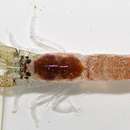Comprehensive Description
provided by Smithsonian Contributions to Zoology
Metalpheus paragracilis (Coutière, 1897)
Alpheus paragracilis Coutière,1897b:304.—Chace, 1966:627; 1972:78.
Metalpheus paragracilis.—D.M. and A.H. Banner, 1982:282, fig. 86.
MATERIAL.—Manning 1971 Collection: Sta ASC-11, English Bay: 1 male [2.5], 3 females [2.0–3.1], 2 ovig. [2.3–3.1], 1 juvenile[1.5].—Sta ASC-12, McArthur Point: 10 males [1.7–3.8], 12 females [1.7–3.8], 5 ovig. [2.5–3.8], 3 juveniles [1.6].—Sta ASC-13, Georgetown: 1 male [2.0],2 ovig. females [2.9–3.0].—Sta ASC-15, English Bay: 7 males [2.4–3.9], 6 females [1.9–3.3], 1 ovig. [2.9], 13 juveniles [1.4–1.6].—Sta ASC-21, English Bay: 3 males [2.0–3.8], 7 females [1.7–3.5], 2 ovig. [3.1–3.5], 3 juveniles [1.5–1.6].—Sta ASC-22, McArthur Point: 11 males [1.7–3.6], 10 females [1.7–2.8], 4 ovig. [2.7–2.8], 4 juveniles [1.4–1.6].—Sta ASC-23, McArthur Point 2 males [2.1–2.8], 4 females [2.0–3.0], 3 ovig. [2.6–3.0].
Smithsonian 1976 Collection: Sta 1B–76, McArthur Point: 2 females [2.7–4.2], 1 ovig. [4.2].—Sta 3D–76, English Bay: 1 male [3.6], 1 ovig. female [3.9].—Sta 5A–76, Shelly Beach: 2 males [3.2–3.3].—Sta 8–76, McArthur Point: 2 males [2.7– 3.3], 5 ovig. females [2.3–3.5].—Sta 9C–76, North East Bay: 2 ovig. females [2.2].
Operation Origin: Site 7, Portland Point in Lithothamnion ball,25 m: 1 female [2.4].
Other Collections: Olson (1970), McArthur Point, sandy bottom tide pool: 7 males [2.3–3.7],2 females [1.8].
SIZE.—Carapace lengths of males, 1.7–3.9 mm; of females, 1.7–4.2 mm; of ovigerous females, 2.2–4.2 mm; of juveniles, 1.4–1.6 mm.
HABITAT.—Most of the specimens listed above were found in tide pools, but some were associated with intertidal rocks, especially in algal mats, and the specimen taken by Operation Origin was found in a Lithothamnion “ball” in 25 meters.
DISTRIBUTION.—Indo-West Pacific region from the Red Sea and Madagascar to Hawaii. The only previous record from the Atlantic was from St. Helena (Chace, 1966:627), now from Ascension; littoral and sublittoral.
- bibliographic citation
- Manning, Raymond B. and Chace, Fenner Albert, Jr. 1990. "Decapod and stomatopod crustaceans from Ascension Island, south Atlantic Ocean." Smithsonian Contributions to Zoology. 1-91. https://doi.org/10.5479/si.00810282.503
Comprehensive Description
provided by Smithsonian Contributions to Zoology
Metalpheus paragracilis (Coutière, 1897)
Alpheus paragracilis Coutière, 1897b:304 [type locality: “l'ile Tague”(?); this origin of the unique holotype was not repeated among the localities listed for the species by Coutière in 1905:883].
Metalpheus paragracilis.—D.M. and A.H. Banner, 1982:282, fig. 86.
DIAGNOSIS.—Rostrum reaching about to level of distal margin of 1st antennular segment; antennal scale overreaching antennular peduncle, lateral margin concave in proximal of length; major chela with distinct shoulder on margin proximal to fixed finger; 2nd pereopod with 2nd carpal article nearly twice as long as wide; 3rd pereopod with merus armed with strong distal tooth on flexor margin; maximum carapace length about 7 mm.
RANGE.—Probably pantropical; intertidal to 20 meters.
Nennalpheus A.H. and D.M. Banner, 1981
Nennalpheus A.H. and D.M. Banner, 1981:219 [type species, by original designation: Alpheopsis Sibogae De Man, 1910:307; gender: masculine].
DIAGNOSIS.—Body not unusually compressed from side to side; rostrum distinct, acute in lateral aspect; carapace without high carina throughout length of dorsal midline; abdomen with or without triangular flap articulated at posterolateral angle of 6th somite; telson not terminating posteriorly in triangular tooth; eyes largely concealed from dorsal view, partially visible from other aspects; mandible with palp and molar process; 3rd maxilliped not unusually broadened to form partial operculum over other mouthparts; 1st pereopods similar, carried extended with movable finger ventral, without molar-like tooth; 2nd pereopod with fingers no shorter than palm, carpus with 5 articles; pereopods with strap-like epipods on 4 anterior pairs.
RANGE.—Philippines and Indonesia; 19 to at least 208 meters.
- bibliographic citation
- Chace, Fenner Albert, Jr. 1997. "The Caridean shrimps (Crustacea:Decapoda) of the Albatross Philippine Expedition, 1907-1910, Part 7: Families Atyidae, Eugonatonotidae, Rhynchocinetidae, Bathypalaemonidae, Processidae, and Hippolytidae." Smithsonian Contributions to Zoology. 1-106. https://doi.org/10.5479/si.00810282.381.1

